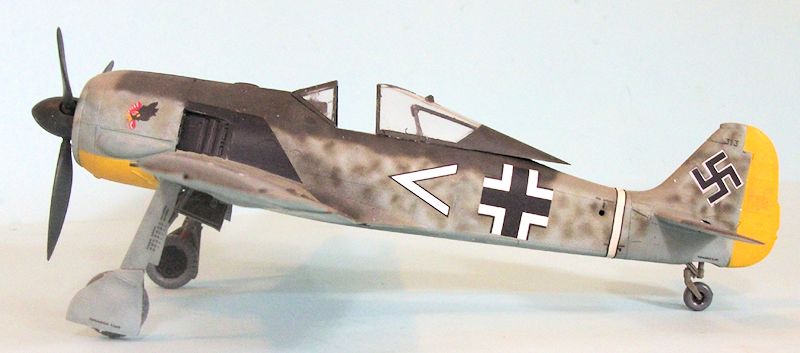
Hasegawa 1/48 FW-190A-3
| KIT #: | 09090 |
| PRICE: | $30.00 SRP |
| DECALS: | Three options |
| REVIEWER: | Tom Cleaver |
| NOTES: |

| HISTORY |
In the fall of
1941, just as the RAF was beginning to get a handle on dealing with the
Messerschmitt Bf-109F in its “Non-Stop Offensive” (called by the Germans with
good reason “The Nonsense Offensive”), a new player arrived on the scene: a low
wing, highly-maneuverable, speedy radial-engined fighter. In his autobiography,
“Wing Leader,” Johnny Johnson recorded that pilots were outraged when RAF
“Intelligence” tried to explain away this new super-fighter as being old Curtiss
Hawk 75s previously operated by the French Air Force that had been taken over by
the Germans as a result of their “fighter shortage.”
The only maneuver a Spitfire V could perform better than
the new fighter was turning, and as Wing Leader Al Deere commented, “turning
doesn’t win battles.”
The airplane was Kurt Tank’s Fw-190, known to the
Germans as 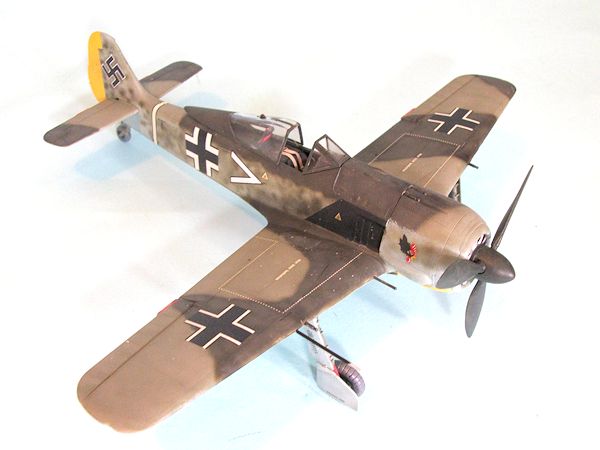 “the
second iron in the fire.”
Goering, who was afraid the British might learn of the
airplane if one crashed in England, issued an order in June 1942 forbidding an
Fw-190 pilot from flying further from France than the midway point of the
English Channel.
“the
second iron in the fire.”
Goering, who was afraid the British might learn of the
airplane if one crashed in England, issued an order in June 1942 forbidding an
Fw-190 pilot from flying further from France than the midway point of the
English Channel.
The Fw-190 was so
clearly superior to the Spitfire Mk.V that RAF Fighter Command was forced to
curtail operations between
November 1941 to March 1942, and again from 13 June 1942
because of unacceptably high losses that were reminiscent of the losses 25 years
earlier over the Somme during “Bloody April,” against the Luftwaffe's new
"Butcher Bird".
The British were so keen to get hold of one and learn its secrets
that there was serious planning for a commando raid on a German Channel
airfield, to capture one and have test pilot Jeffrey Quill fly it back to
Britain.
On June 23, 1942,
Leutnant Armin Faber, Gruppe Adjutant
of III/JG 2, saved them the effort.
Faber, whose staff job kept him out of the cockpit more
than he liked, talked his way onto a flight when 7./JG 2 scrambled to respond to
a British air raid of 12 Bostons and their escorting Spitfires.
On takeoff he discovered his radio was out, but he
continued on. The British force was intercepted and a wild fight developed over
the Channel with the escorting Spitfires.
Trying to get back to France but actually flying north
toward England, Faber was attacked by Sergeant František Trejtnar of 310
Squadron. Faber flew north over Exeter in Devon, trying to get away. Finally
Faber pulled an Immelman turn into the late afternoon sun and shot down Trejnar
in a head‑on attack.
Trejnar baled out safely, but Faber, disoriented,
mistook the Bristol Channel for the English Channel and flew north instead of
south. Believing he was over France instead of South Wales, he turned towards
the nearest airfield, which turned out to be
RAF Pembrey. Those on the ground couldn’t believe their
eyes when Faber executed a victory roll over the field, lowered his gear and
landed.
In the control
tower, F/Sgt Jeffreys, the Pembrey Duty Pilot, grabbed a Very pistol and ran
across the field and jumped onto the wing of Faber's aircraft as it taxied in.
The amazed Faber climbed out with his hands held high.
Faber’s airplane
was so new it still had the “new airplane smell” in its cockpit, with the
Werke nummer 313.
It was disassembled and trucked to Farnborough after
Group Captain Hugh Wilson refused the duty after he was asked to fly it from
Pembrey to Farnborough under the guarantee not to crash.
 Testing and evaluation of the airplane began on July 3, 1942 at the Royal
Aircraft Establishment. Nine flying hours were recorded over ten days, which
provided the RAF with extremely valuable intelligence.
The airplane could indeed outmaneuver and outfly the
Spitfire V in everything but turning radius, and was so closely matched to the
new Spitfire IX that the outcome of any fight between the two types would depend
on individual pilot skill.
Adding insult to injury was the discovery that the BMW
801 engine had been de-rated from 1,650 to 1,400 h.p. to prolong the life of the
engine!
Testing and evaluation of the airplane began on July 3, 1942 at the Royal
Aircraft Establishment. Nine flying hours were recorded over ten days, which
provided the RAF with extremely valuable intelligence.
The airplane could indeed outmaneuver and outfly the
Spitfire V in everything but turning radius, and was so closely matched to the
new Spitfire IX that the outcome of any fight between the two types would depend
on individual pilot skill.
Adding insult to injury was the discovery that the BMW
801 engine had been de-rated from 1,650 to 1,400 h.p. to prolong the life of the
engine!
The Fw-190 was
then transferred to the the Air Fighting Development Unit for tactical
assessment.
It was flown 29 times between July 3, 1942 and January 29, 1943
after which it was partially dismantled and tests done on engine performance at
Farnborough. It was struck off charge and scrapped in September 1943.
There has long
been controversy over this story, with some sources alleging that Faber actually
defected with his airplane as part of a plot pulled off by British Intelligence.
However, the facts are that Faber became a POW and was
transferred to Canada, where he made two unsuccessful escape attempts and then
managed to convince his jailers that he suffered from epilepsy.
He was repatriated to Germany in 1944, where he rejoined
the Jagdwaffe and resumed flying
combat.
The forward part
of the Faber Fw-190 cockpit was preserved and later obtained by the Shoreham
Aircraft Museum at Shoreham Village near Sevenoaks, Kent where it is on display.
On September 21, 1991 Armin Faber visited the Museum and
donated his Officer’s dagger and pilot’s badge for the display.
| THE KIT |
Hasegawa first
released the Fw-190A-3/4 in 1995; the kit was basically the Dragon kit with a
new shorter nose cowling and gun bay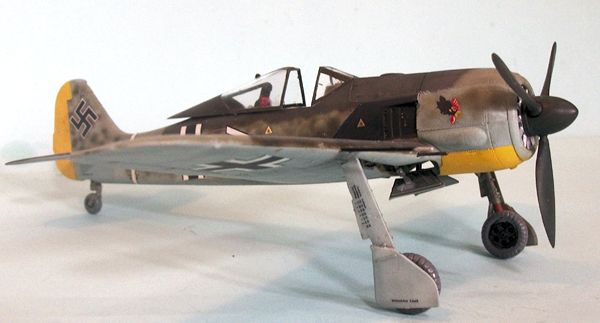 cover and gear leg doors.
That limited release disappeared for several years, and
then in around 2003 it reappeared; this time it had been modified from the
Dragon original with the fuselage modified to not have the large lower open area
which had meant modelers needed to put in spreader bars to get the proper
wing/fuselage join. The gear legs had also been modified to make them only able
to be attached in the right alignment (failing to get the alignment right on
Fw-190 kits has been the downfall of many modelers who put in lots of effort on
their model, only to lose in a competition at the first run-through for this
common mistake), and the ailerons were separate.
Two different sets of horizontal stabilizers were
included along with the forward part of the upper fin, which allowed a modeler
to complete the kit as an Fw-190A-3 or Fw-190A-4.
cover and gear leg doors.
That limited release disappeared for several years, and
then in around 2003 it reappeared; this time it had been modified from the
Dragon original with the fuselage modified to not have the large lower open area
which had meant modelers needed to put in spreader bars to get the proper
wing/fuselage join. The gear legs had also been modified to make them only able
to be attached in the right alignment (failing to get the alignment right on
Fw-190 kits has been the downfall of many modelers who put in lots of effort on
their model, only to lose in a competition at the first run-through for this
common mistake), and the ailerons were separate.
Two different sets of horizontal stabilizers were
included along with the forward part of the upper fin, which allowed a modeler
to complete the kit as an Fw-190A-3 or Fw-190A-4.
| CONSTRUCTION |
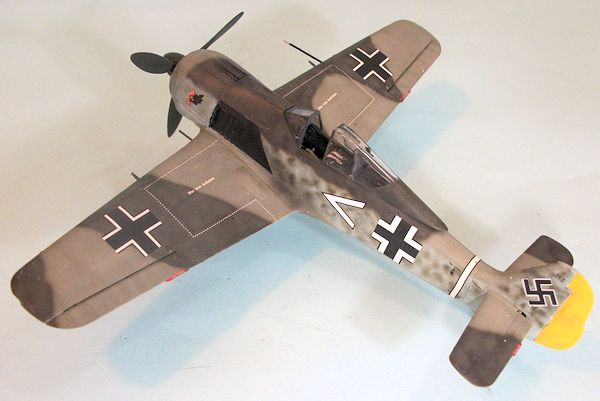
| COLORS & MARKINGS |
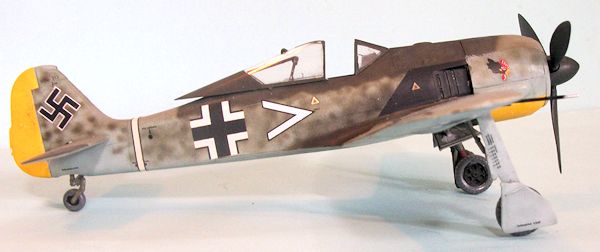
| FINAL BITS |
| CONCLUSIONS |

April 2013
If you would like your product reviewed fairly and fairly quickly, please contact the editor or see other details in the Note to Contributors.